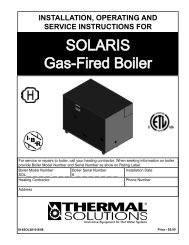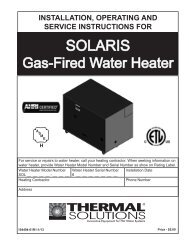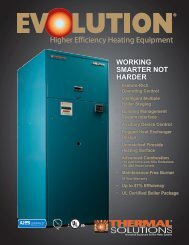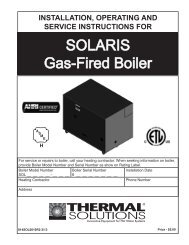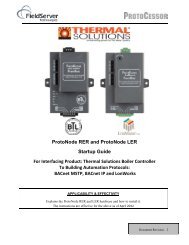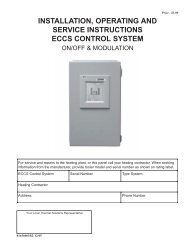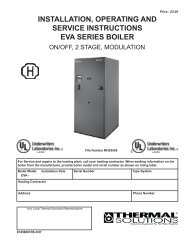installation, operating and service instructions evca series ...
installation, operating and service instructions evca series ...
installation, operating and service instructions evca series ...
You also want an ePaper? Increase the reach of your titles
YUMPU automatically turns print PDFs into web optimized ePapers that Google loves.
WARNING<br />
Failure to operate the unit with the proper water<br />
flow rate can lead to appliance failure. Always<br />
verify proper water flow switch operation so that<br />
the unit stops <strong>operating</strong> if improper water flow is<br />
present.<br />
Safety relief valve discharge piping must be<br />
piped such that the potential of severe burns<br />
is eliminated. DO NOT pipe in any area where<br />
freezing could occur. DO NOT install any shutoff<br />
valves, plugs or caps. Consult Local Codes<br />
for proper discharge piping arrangement.<br />
If a high head system pump is installed, ensure<br />
that the boiler relief valve <strong>and</strong> system piping are<br />
capable of <strong>operating</strong> properly at the combined<br />
pressure of the system fill pressure plus the<br />
pump static head pressure.<br />
Do not install valves, plugs or caps in safety<br />
relief valve piping.<br />
supplier or local plumbing inspector on how best to<br />
control this situation.<br />
12. A pressure relief valve is supplied with each boiler.<br />
No valve is to be placed between the relief valve <strong>and</strong><br />
appliance.<br />
a. Pipe the safety relief discharge to a suitable place<br />
for disposal when relief occurs.<br />
b. Do not install reducing couplings or other<br />
restrictive devices in the safety relief discharge<br />
line.<br />
c. The safety relief discharge line must allow for<br />
complete drainage of both the valve <strong>and</strong> line.<br />
13. If the relief valve discharges periodically, this may be<br />
due to thermal expansion in a closed water supply<br />
system. Contact the water supplier or local plumbing<br />
inspector on how to correct this situation. DO NOT<br />
PLUG THE RELIEF VALVE.<br />
Safety relief valve piping must be terminated<br />
such that in the event the safety relief valve<br />
opens, the discharge will not cause personal<br />
injury or damage.<br />
Do not operate the boiler with flow rates in<br />
excess of the maximum flow rates listed in Table<br />
1B Tube erosion <strong>and</strong> pitting will occur. Thermal<br />
Solutions St<strong>and</strong>ard Warranty does not cover<br />
problems caused by excessive water flow rates.<br />
9. Refer to Table 1B for pressure drop, flow rates, <strong>and</strong><br />
temperature rise (ΔTs).<br />
10. The factory supplied circulator is not intended to<br />
replace the boiler supply circulator or the system<br />
supply circulator. It provides a constant flow to the<br />
primary heat exchanger.<br />
11. If the boiler is installed in a closed water supply<br />
system, such as one having a back flow preventer in<br />
the cold water supply line, means shall be provided<br />
to control thermal expansion. Contact the water<br />
BOILER<br />
MODEL<br />
DP<br />
(Ft. hd)<br />
Table 1B- EVCA BOILER FLOW AND PRESSURE DROP<br />
*20°F ∆T 30°F ∆T 40°F ∆T 50°F ∆T 60°F ∆T 70°F ∆T<br />
GPM<br />
DP<br />
(Ft. hd)<br />
GPM<br />
DP<br />
(Ft. hd)<br />
GPM<br />
DP<br />
(Ft. hd)<br />
GPM<br />
DP<br />
(Ft. hd)<br />
GPM<br />
DP<br />
(Ft. hd)<br />
EVCA-750 32.4 70 17.8 47 11.6 35 8.3 28 6.3 23 5.0 20<br />
EVCA-1000 36.9 94 20.9 63 13.9 47 10.2 38 7.9 31 6.4 27<br />
EVCA-1500 53.7 142 27.3 95 16.9 71 11.7 57 8.6 47 6.7 41<br />
EVCA-2000 67.8 190 36.0 127 23.0 95 16.2 76 12.2 63 9.6 54<br />
EVCA-3000 29.2 291 15.2 194 9.6 146 6.7 116 5.0 97 3.9 83<br />
Note: * Indicates maximum allowable flow rate.<br />
GPM<br />
20



